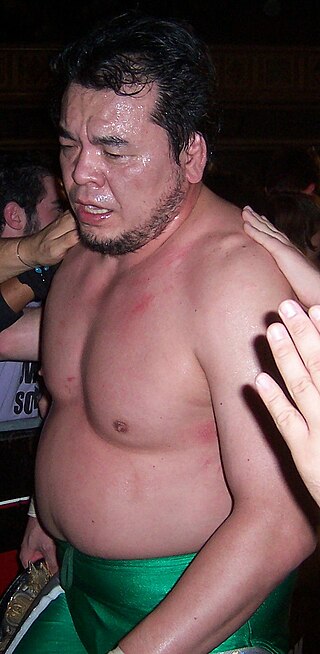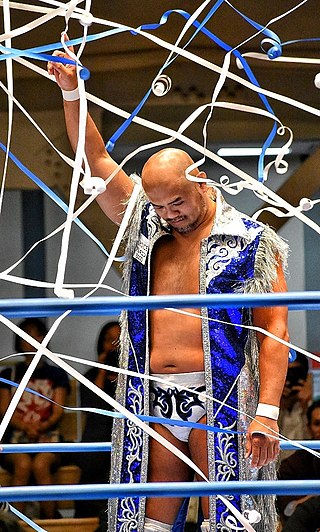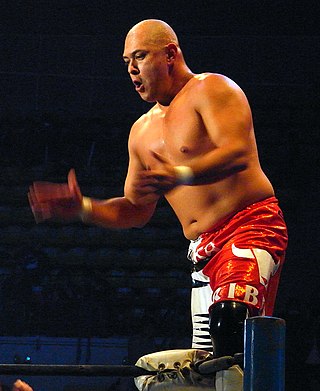Related Research Articles
All Japan Pro Wrestling (AJPW/AJP) or simply All Japan is a Japanese professional wrestling promotion established on October 21, 1972 when Giant Baba split away from the Japanese Wrestling Association and created his own promotion. Many wrestlers had left with Baba, with many more joining the following year when JWA folded. From the mid-1970s, All Japan was firmly established as the largest promotion in Japan. As the 1990s began, aging stars gave way to a younger generation including Mitsuharu Misawa, "Dr. Death" Steve Williams, Kenta Kobashi, Gary Albright, Toshiaki Kawada, Mike Barton, Akira Taue and Jun Akiyama, leading to perhaps AJPW's most profitable period in the 1990s.

Mitsuharu Misawa was a Japanese amateur and professional wrestler and promoter. He is primarily known for his time in All Japan Pro Wrestling (AJPW), and also for forming the Pro Wrestling Noah promotion in 2000. In the early 1990s, Misawa gained fame alongside Toshiaki Kawada, Kenta Kobashi, and Akira Taue, who came to be nicknamed AJPW's "Four Pillars of Heaven", and whose matches developed the ōdō style of puroresu and received significant critical acclaim. Despite never working in the United States during the 1990s, Misawa had significant stylistic influence upon American independent wrestling, through the popularity of his work among tape-traders in the country. Misawa is regarded by some as the greatest professional wrestler of all time. However, the physical demands and consequences of the style in which he worked and the circumstances of his death have made his legacy, or at least that of ōdō, somewhat problematic.
Tsuyoshi Kikuchi is a Japanese retired professional wrestler. He is best known for All Japan Pro Wrestling and Pro Wrestling NOAH. Kikuchi idolized and patterned his style after the Dynamite Kid.

Kenta Kobashi is a Japanese former professional wrestler. He started his career in All Japan Pro Wrestling (AJPW) in 1988, where he became one of the promotion's top stars, holding the Triple Crown Heavyweight Championship three times, and winning the Champion Carnival in 2000. Kobashi left All Japan in June 2000, taking part in a mass exodus led by Mitsuharu Misawa, which led to the formation of Pro Wrestling Noah. Widely regarded as one of the greatest professional wrestlers of all time, Kobashi worked for Noah for thirteen years, and became the longest reigning GHC Heavyweight Champion of all time, holding the championship for 735 days between 2003 and 2005, a record that stands to this day. He was a four-time world champion.

Jun Akiyama is a Japanese professional wrestler signed to DDT Pro-Wrestling, where he is a former KO-D Openweight Champion. He is best known for his time working for All Japan Pro Wrestling (AJPW), where he was the president, representative director, co-head booker, and an in-ring performer. In AJPW, he is a former two-time Triple Crown Heavyweight Champion, while also being a six-time overall professional wrestling world champion.
Akira Taue is a Japanese retired professional wrestler. He is also a former All Japan Pro Wrestling Triple Crown Heavyweight Champion, a former GHC Heavyweight Champion and has had fourteen 5 Star Matches as awarded by the Wrestling Observer Newsletter.

Yoshihiro Takayama is a former Japanese professional wrestler and mixed martial artist. Debuting for UWF International (UWFI) in the 1990s, Takayama joined All Japan Pro Wrestling (AJPW) in 1997 after UWF-i folded. In 2000, he joined Pro Wrestling Noah (Noah), and later became a mainstay in New Japan Pro-Wrestling (NJPW) where he arguably achieved his greatest success, holding the IWGP Heavyweight Championship and NWF Heavyweight Championship simultaneously in 2003. He is one of only five men to hold all three puroresu major heavyweight titles, the others being Kensuke Sasaki, Keiji Muto, Satoshi Kojima, and Yuji Nagata.

Toshiaki Kawada is a Japanese semi-retired professional wrestler best known for his work in All Japan Pro Wrestling (AJPW), whom he worked for from his debut in 1982 up until 2008. In All Japan, he was a 5 time Triple Crown Heavyweight Champion, a 9 time World Tag Team Champion, three time winner of the Real World Tag League and a two time winner of the Champion Carnival. He was also recognised as the ace of the promotion from 2000 to 2005.

Maunakea Mossman is an American semi-retired professional wrestler, better known under his stage name Taiyō Kea (太陽ケア). Best known for his work in All Japan Pro Wrestling (AJPW), he is the only wrestler in AJPW's history to have held the Triple Crown Heavyweight Championship, the World Tag Team Championship and the World Junior Heavyweight Championship.

Akitoshi Saito is a Japanese professional wrestler who is best known for his work in New Japan Pro-Wrestling (NJPW) and Pro Wrestling Noah (Noah).
Takeshi Inoue known by his stage name Takeshi Rikiō, is a Japanese retired professional wrestler, who worked for Pro Wrestling Noah. He is also a former sumo wrestler.
Kentaro Shiga is a Japanese professional wrestler, currently working as a freelancer. He returned from a two-year hiatus due to injury in 2005.

Masanobu Fuchi is a Japanese professional wrestler currently signed to All Japan Pro Wrestling (AJPW), where he is also a director and the co-head booker. Fuchi has exclusively worked for All Japan since his debut in 1974, and holds the record for the longest World Junior Heavyweight Championship reign at 1,309 days. Fuchi became a freelancer in 2009, but officially re-signed with AJPW in 2013 as both a director and wrestler, making him the longest tenured member of the All Japan roster.
Richard Aslinger is a retired American professional wrestler, known by his ring name Richard Slinger. Slinger was a long-time mainstay of All Japan Pro Wrestling and later Pro Wrestling Noah, where he was one of two gaijin heels to compete in the promotion. He is also one of several Noah wrestlers to be featured in the Japanese video game King of Colosseum II.
No Fear was a professional wrestling tag team that consisted of Takao Omori and Yoshihiro Takayama. During their history, the team competed in All Japan Pro Wrestling and Pro Wrestling Noah.
Wild Burning is a tag team composed of Japanese professional wrestlers Jun Akiyama and Takao Omori. Although Akiyama and Omori have been using the team name since 2013, their team goes back almost to the era of their debut in All Japan Pro Wrestling in the early 1990s. The name is a portmanteau of their previous stables Burning (Akiyama) and Get Wild (Omori).
The Champion Carnival is a professional wrestling tournament held by All Japan Pro Wrestling (AJPW). The tournament is also known by the nickname Haru no Saiten and is sometimes abbreviated to CC. Created by AJPW founder Giant Baba, the tournament has been held annually since 1973 and is the longest-running singles tournament in professional wrestling, while also ranking as the most prestigious event in the AJPW calendar. It is considered a successor to the World League, held by Japan Pro Wrestling Alliance (JWA) between 1959 and 1972, predating the New Japan Pro-Wrestling (NJPW) G1 Climax tournament by a year.

Departure was a major professional wrestling event produced by Pro Wrestling Noah. The event took place on July 10, 2004 at the Tokyo Dome in Tokyo, Japan, and marked Noah's first ever show in the arena.

The 2000 All Japan Pro Wrestling mass exodus was an incident in the Japanese All Japan Pro Wrestling (AJPW) professional wrestling promotion that took place throughout May and June 2000, and culminated in 24 of the 26 contracted native wrestlers leaving the promotion. Led by Mitsuharu Misawa, they later formed their own promotion, Pro Wrestling Noah.
This is a list of Japanese professional wrestler Mitsuharu Misawa's championships and accomplishments. Misawa (1962-2009) debuted for All Japan Pro Wrestling (AJPW) in 1981, and began work as the second incarnation of the Tiger Mask gimmick in 1984. He achieved some success as the character, but when he unmasked mid-match in May 1990, Misawa was pushed to the top of the company, and became one of AJPW's most decorated wrestlers of the 1990s. When he led a mass exodus to start his promotion Pro Wrestling Noah, he continued to have great success until his death in an in-ring accident. Misawa also received significant critical acclaim from domestic and international publications throughout his career.
References
- 1 2 "Holy Demon Army". Puroresucentral.com. Retrieved 2016-05-11.
- 1 2 "Purolove.Com". Purolove.com. Retrieved 2016-05-11.
- ↑ "Purolove.Com". Purolove.com. Retrieved 2016-05-11.
- 1 2 3 4 5 6 "All Japan World Tag League Championship". Puroresucentral.com. Retrieved 2016-05-11.
- ↑ "All Japan Real World Tag League Page 3". Puroresucentral.com. Retrieved 2016-05-11.
- ↑ "Jumbo Tsuruta". Puroresucentral.com. Retrieved 2016-05-11.
- 1 2 3 4 "Purolove.Com". Purolove.com. Retrieved 2016-05-11.
- ↑ "Purolove.Com". Purolove.com. Retrieved 2016-05-11.
- ↑ "Purolove.Com". Purolove.com. Retrieved 2016-05-11.
- ↑ "Purolove.Com". Purolove.com. Retrieved 2016-05-11.
- 1 2 "Purolove.Com". Purolove.com. Retrieved 2016-05-11.
- ↑ "Purolove.Com". Purolove.com. Retrieved 2016-05-11.
- ↑ "Purolove.Com". Purolove.com. Retrieved 2016-05-11.
- 1 2 3 "PUROLOVE.com".
- ↑ "PUROLOVE.com".
- ↑ "Purolove.Com". Purolove.com. Retrieved 2016-05-11.
- 1 2 3 4 "All Japan Triple Crown Championship". Puroresucentral.com. Retrieved 2016-05-11.
- ↑ "Purolove.Com". Purolove.com. Retrieved 2016-05-11.
- ↑ "Purolove.Com". Purolove.com. Retrieved 2016-05-11.
- ↑ "Purolove.Com". Purolove.com. Retrieved 2016-05-11.
- ↑ "Purolove.Com". Purolove.com. Retrieved 2016-05-11.
- 1 2 "Purolove.Com". Purolove.com. Retrieved 2016-05-11.
- 1 2 "Purolove.Com". Purolove.com. Retrieved 2016-05-11.
- ↑ "Purolove.Com". Purolove.com. Retrieved 2016-05-11.
- ↑ "Purolove.Com". Purolove.com. Retrieved 2016-05-11.
- ↑ "Purolove.Com". Purolove.com. Retrieved 2016-05-11.
- ↑ "Purolove.Com". Purolove.com. Retrieved 2016-05-11.
- ↑ "Purolove.Com". Purolove.com. Retrieved 2016-05-11.
- 1 2 "Purolove.Com". Purolove.com. Retrieved 2016-05-11.
- ↑ "Great Voyage 2013 in Tokyo vol.2~田上明引退記念大会~". Pro Wrestling Noah (in Japanese). Retrieved 2013-12-07.
- ↑ "Archived copy". Archived from the original on March 25, 2009. Retrieved August 5, 2008.
{{cite web}}: CS1 maint: archived copy as title (link) - 1 2 "The Great Hisa's Puroresu Dojo: Puroresu Awards: 1990s". Puroresu Dojo.